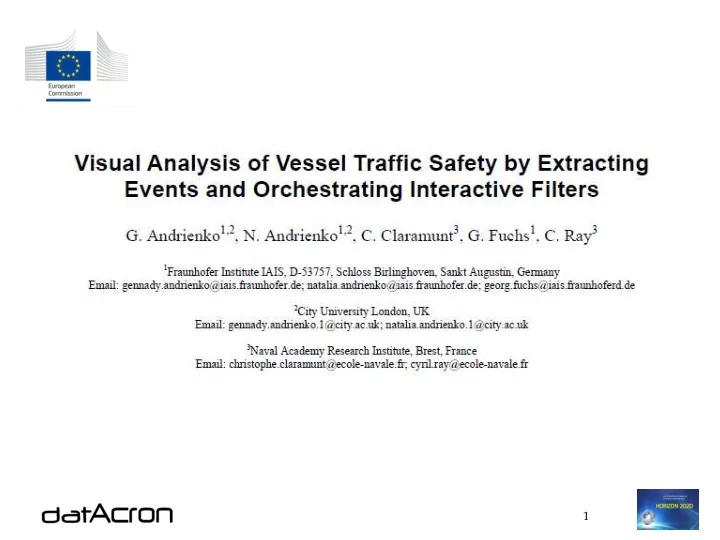

1
• http://www.datacron-project.eu/ (awarded in Big Data Reseacrh call 2015) 2
Data: AIS-collected dataset consists of 5,244 trajectories of vessels • that moved in the bay of Brest (France) in the time period of 313 days from the 11th of February till 21st of December, 2009 • The study area and the density of vessel trajectories. Left: all trajectories; Right: trajectories going through the strait 3
instant, interval, and cumulative characteristics of the movement; • • additional attributes measured along the trajectories, such as altitude or temperature, when available in the original data; date/time components of the time references, e.g., day of the week • or hour of the day; • attributes expressing relations to the spatio-temporal context (static and moving objects or events) 4
• spatial context elements (SCE): static spatial objects; arbitrarily chosen locations; specific locations in a trajectory such as the start position, end position, middle, and medoid (the closest position to all other positions); • temporal context elements (TCE): events; arbitrarily chosen time moments; specific time moments in a trajectory such as start time, end time, half-way time, etc.; • spatio-temporal context elements (STCE): moving objects; spatial events; positions <time, location> of a trajectory. 5
• spatial distance – to the nearest or the n th nearest SCE; – to the nearest or to the n th nearest STCE within a given temporal window; • temporal distance – to the nearest or to the n th nearest TCE; – to the nearest or to the n th nearest STCE within a given spatial window; • neighborhood: – count of SCE within a given spatial window; – count of TCE within a given temporal window; – count of STCE within given spatial and temporal windows 6
Event DD/MM/YY 7
Event DD/MM/YY 8
Event DD/MM/YY 9
Event DD/MM/YY 10
Event DD/MM/YY 11
Event DD/MM/YY 12
Event DD/MM/YY 13
• Instances of close approach may indicate near-collisions but also other events of interest, such as tugging, boarding, or smuggling. • Left: The traffic through the strait at the times of occurrence of the near-location events. Right: The traffic in the remaining times. Difference: high density of lane switching • in the left 14
Events of high sinuosity that occurred in or near the major traffic • lanes. 326 out of the 334 sinuosity events occurred in the trajectories that also had near-location events 15
• Weighted density of the trajectory segments where the distances to the nearest vessels are below 100 metres. Sinuosity values are used as the weights. • We can conclude that the anomalous events can be attributed to intersecting traffic flows at the times of increased amounts of outgoing traffic from the Brest harbour. 16
Spatial filtering for selecting data within an area of interest and for • excluding analysis-irrelevant data (e.g., events that occurred inside the harbour). • Time mask filter, which selects multiple disjoint time intervals based on given conditions and excludes the remaining time intervals. We used it for selecting the times when near-location events occurred. • Filter of trajectory segments, which selects parts of trajectories based on movement attributes, either pre-existing or derived, such as the distance to the nearest neighbour and path sinuosity in a time window. • Filter of related object sets, which allowed us to select the trajectories in which near-location events happened and then the sinuosity events that occurred in the selected trajectories. 17
18
Event DD/MM/YY 19
? 21
Recommend
More recommend